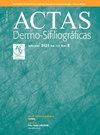皮肤病生活质量指数
IF 3.8
Q1 DERMATOLOGY
引用次数: 0
摘要
背景和目的:先前在哥伦比亚基于经典测试理论(CTT)观点的皮肤病学-生命质量指数(DLQI)验证结果表明,需要深入研究其测量特性。因此,我们旨在通过项目反应理论(IRT)或Rasch模型来评估DLQI的结构效度、内部一致性和项目反应分析。材料和方法:我们评估DLQI的维度,确定其难度、鉴别和鉴别功能,并进一步评估其在炎症性和非炎症性皮肤病患者中的内部一致性和鉴别效度。我们招募了患有不同皮肤病的哥伦比亚患者。结果:865例患者资料,平均年龄49.3岁;(61%为女性)。dlqi评分范围从0到30。二分类项目#7的内部一致性显示麦当劳ω系数为0.85 (95%CI, 0.84-0.87), Cronbach's α系数为0.86 (95%CI, 0.84-0.88)。对于序号项目#7,麦当劳的ω系数为0.87 (95%CI:0.85-0.89), Cronbach's α系数为0.84 (95%CI: 0.82-0.87)。霍恩的并行分析揭示了DLQI单维性的存在,并有一个单因子解。只有1号物品符合PCM模型。其余的项目,包括项目#9,由于重叠的反应和顺序的变化,没有显示出足够的契合度。结论:基于Rasch分析的DLQI-COL的有效性证明不是评估皮肤人群生活质量的合适工具。需要一个具有充分的跨文化适应和验证过程的改进版本的量表,以获得一个适当和可靠的工具版本,用于测量哥伦比亚皮肤病患者的生活质量。 本文章由计算机程序翻译,如有差异,请以英文原文为准。
[Artículo traducido] Análisis Rasch del índice de calidad de vida en dermatología
Background and aims
Previous results of the Dermatology-Life-Quality-Index (DLQI) validation in Colombia based on the classical test theory (CTT) perspective have showed the need to delve into its measurement properties. Therefore, we aimed to assess the structural validity, internal consistency and item response analysis of the DLQI through the item response theory (IRT) or the Rasch model.Material and methods
We assessed the dimensionality of the DLQI, determined its difficulty, discrimination and differential functioning and went on to evaluate its internal consistency and discriminative validity among patients with inflammatory and non-inflammatory skin disease. We recruited Colombian patients with different skin diseases.Results
Data of 865 patients (mean age, 49.3 years; 61% females) were included. DLQI-scores ranged from 0 up to 30. Internal consistency for dichotomous item #7 showed a McDonald's Omega coefficient of 0.85 (95% CI: 0.84-0.87) and a Cronbach's α coefficient of 0.86 (95% CI: 0.84-0.88). For ordinal item #7, the McDonald's Omega coefficient was 0.87 (95% IC: 0.85-0.89) and Cronbach's α coefficient, 0.84 (95% CI: 0.82-0.87). Horn's parallel analysis revealed the presence of DLQI unidimensionality with a 1-factor solution. Only item #1 fitted the PCM model. The remaining items, including item #9, did not show adequate fit due to overlapping responses and order changes.Conclusions
The validity of DLQI-COL based on Rasch analysis proved not to be a suitable instrument to evaluate QoL in our dermatologic population. A refined version of the scale with an adequate cross-cultural adaptation and validation process is needed to obtain an appropriate and reliable version of the instrument for QOL measuring in Colombian patients with skin diseases.
摘要
背景和目的:先前在哥伦比亚基于经典测试理论(CTT)观点的皮肤病学-生命质量指数(DLQI)验证结果表明,需要深入研究其测量特性。因此,我们旨在通过项目反应理论(IRT)或Rasch模型来评估DLQI的结构效度、内部一致性和项目反应分析。材料和方法:我们评估DLQI的维度,确定其难度、鉴别和鉴别功能,并进一步评估其在炎症性和非炎症性皮肤病患者中的内部一致性和鉴别效度。我们招募了患有不同皮肤病的哥伦比亚患者。结果:865例患者资料,平均年龄49.3岁;(61%为女性)。dlqi评分范围从0到30。二分类项目#7的内部一致性显示麦当劳ω系数为0.85 (95%CI, 0.84-0.87), Cronbach's α系数为0.86 (95%CI, 0.84-0.88)。对于序号项目#7,麦当劳的ω系数为0.87 (95%CI:0.85-0.89), Cronbach's α系数为0.84 (95%CI: 0.82-0.87)。霍恩的并行分析揭示了DLQI单维性的存在,并有一个单因子解。只有1号物品符合PCM模型。其余的项目,包括项目#9,由于重叠的反应和顺序的变化,没有显示出足够的契合度。结论:基于Rasch分析的DLQI-COL的有效性证明不是评估皮肤人群生活质量的合适工具。需要一个具有充分的跨文化适应和验证过程的改进版本的量表,以获得一个适当和可靠的工具版本,用于测量哥伦比亚皮肤病患者的生活质量。本文章由计算机程序翻译,如有差异,请以英文原文为准。
[Artículo traducido] Análisis Rasch del índice de calidad de vida en dermatología
Background and aims
Previous results of the Dermatology-Life-Quality-Index (DLQI) validation in Colombia based on the classical test theory (CTT) perspective have showed the need to delve into its measurement properties. Therefore, we aimed to assess the structural validity, internal consistency and item response analysis of the DLQI through the item response theory (IRT) or the Rasch model.
Material and methods
We assessed the dimensionality of the DLQI, determined its difficulty, discrimination and differential functioning and went on to evaluate its internal consistency and discriminative validity among patients with inflammatory and non-inflammatory skin disease. We recruited Colombian patients with different skin diseases.
Results
Data of 865 patients (mean age, 49.3 years; 61% females) were included. DLQI-scores ranged from 0 up to 30. Internal consistency for dichotomous item #7 showed a McDonald's Omega coefficient of 0.85 (95% CI: 0.84-0.87) and a Cronbach's α coefficient of 0.86 (95% CI: 0.84-0.88). For ordinal item #7, the McDonald's Omega coefficient was 0.87 (95% IC: 0.85-0.89) and Cronbach's α coefficient, 0.84 (95% CI: 0.82-0.87). Horn's parallel analysis revealed the presence of DLQI unidimensionality with a 1-factor solution. Only item #1 fitted the PCM model. The remaining items, including item #9, did not show adequate fit due to overlapping responses and order changes.
Conclusions
The validity of DLQI-COL based on Rasch analysis proved not to be a suitable instrument to evaluate QoL in our dermatologic population. A refined version of the scale with an adequate cross-cultural adaptation and validation process is needed to obtain an appropriate and reliable version of the instrument for QOL measuring in Colombian patients with skin diseases.
求助全文
通过发布文献求助,成功后即可免费获取论文全文。
去求助
来源期刊

Actas dermo-sifiliograficas
DERMATOLOGY-
CiteScore
1.90
自引率
9.40%
发文量
473
审稿时长
56 weeks
期刊介绍:
Actas Dermo-Sifiliográficas, publicación Oficial de la Academia Española de Dermatología y Venereología, es una revista de prestigio consolidado. Creada en 1909, es la revista mensual más antigua editada en España.En 2006 entró en Medline, y hoy resulta imprescindible para estar al día sobre la dermatología española y mundial.
 求助内容:
求助内容: 应助结果提醒方式:
应助结果提醒方式:


